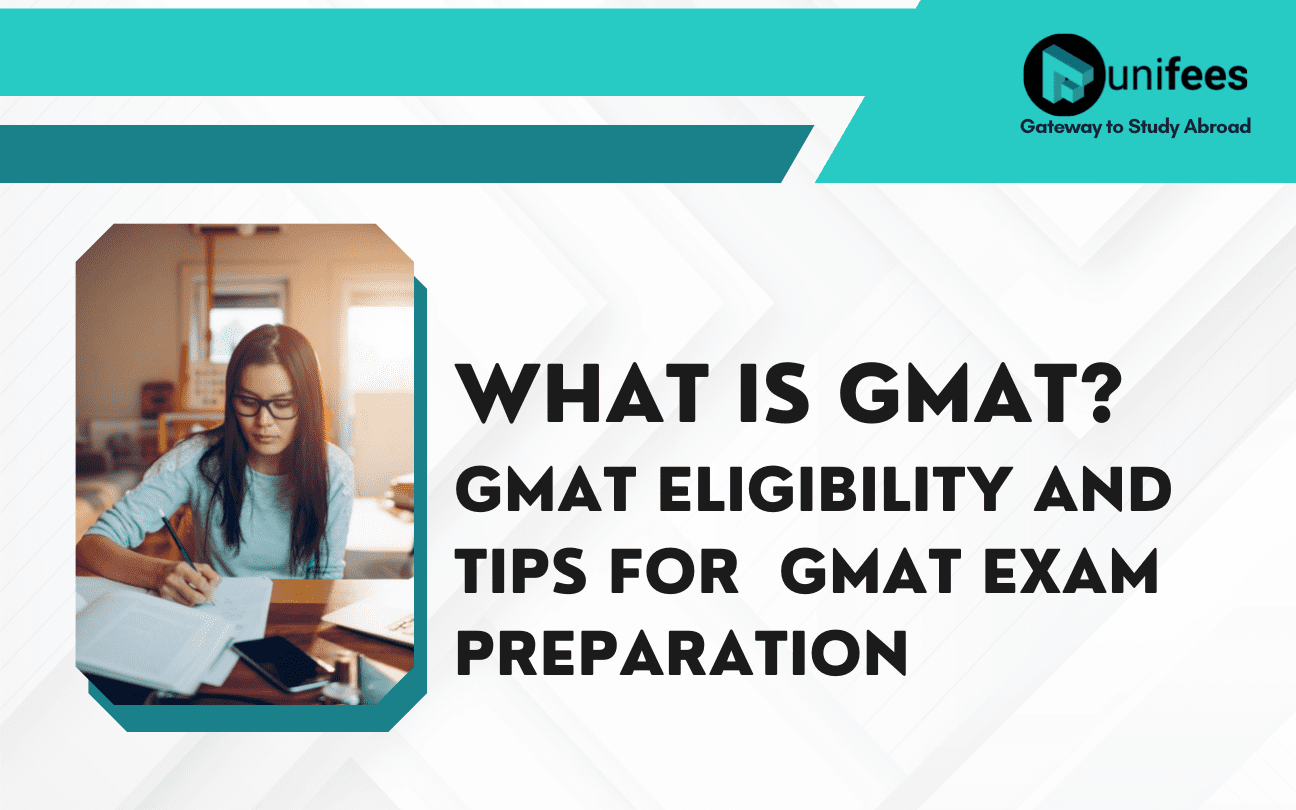What is GMAT or Graduate Management Admission Test?
Have you ever wondered,
“What is GMAT?” Well, GMAT stands for the Graduate Management Admission Test.
It is a standardized, computer-based exam used worldwide as a crucial part of the application process for graduate management or business programs like MBA.
It is designed and administered by the test maker GMAC, the GMAT ensures that business schools can evaluate the readiness of applicants for the demanding academic workload of postgraduate programs.
GMAT score plays a pivotal role in your application, serving as a common measure of your preparedness. A high GMAT score could significantly enhance your business school application and potentially your career trajectory.
This exam is especially important for those looking to study at elite business schools like Harvard, INSEAD, Stanford, or Wharton, providing entry opportunities to over 7000 programs across more than 2300 B-schools in over 110 countries.
GMAT Exam: What it is and Its Significance
If you’re looking to embark on an MBA journey abroad, you’ll likely encounter the term GMAT. Standing for Graduate Management Admission Test, the GMAT exam is an internationally recognized entrance exam that paves the way to some of the most coveted business schools across the globe, including Ivy League institutions like Harvard Business School, INSEAD, Stanford, and Wharton.
What is the GMAT exam for, you may ask? This computer-based test is used to measure your analytical abilities, giving both you and potential universities an indication of your readiness for postgraduate business studies. Overseen by the Graduate Management Admission Council (GMAC), GMAT provides a fair and standard marking scheme applicable to all students globally, eliminating any form of bias.
Going into the GMAT subject specifics, the test provides access to over 7000 programs at more than 2300 B-schools in 110+ countries, making it a universally accepted standard. A high GMAT score can not only help you secure a place in your desired master’s program but can also give you a competitive edge when landing your dream job.
In the recent 5 years, the average GMAT scores of Indian applicants have surpassed those from other nations, highlighting the potential of Indian students. In fact, an excellent GMAT score of between 740 and 750 could increase your chances of acceptance into a top-tier U.S. B-school by 32%, according to the GMAT club.
So, if you’re pondering when to take the GMAT test or need more GMAT exam details, keep in mind that it’s available on-demand and all year round, in both online and offline modes. The GMAT exam is your gateway to global opportunities, an essential stepping stone towards your dream career in business.
Your Guide to GMAT Registration and Costs for 2023
If you’re planning to take a significant step in your academic journey by taking the GMAT (Graduate Management Admission Test) in 2023, understanding the process of GMAT registration and the associated costs is crucial.
This globally recognized exam is your ticket to world-renowned B-schools, providing a chance to escape the mundane and elevate your life and career.
Registering for the GMAT exam involves a simple, streamlined online process, similar to the one for the CAT Exam. Here’s a step-by-step breakdown:
- Create a GMAT Exam Profile: Visit the official GMAT website to create your profile, using a valid email address.
- Choose to Receive Information: Decide if you’d like to receive extra details about financial aid, recruitment processes, offers from GMAC, and more.
- Consider GMASS: Use the GMAT registration process to apply to colleges via GMASS, a platform where consenting students can connect with participating colleges.
- Fill in Personal Details: Provide your name, email address, communication preferences, and address.
- Provide Profile Details: Add your date of birth, gender, native languages, undergraduate program details, work experience, and career aspirations.
- Locate an Exam Center: Identify a nearby GMAT exam centre.
- Finalize Exam Date and Pay Fees: Select your GMAT exam date and pay the required registration fee to complete the registration process.
Now let’s dive into the GMAT cost
In India, the GMAT registration fee is $275, approximately INR 22,000, as of 2023. However, be mindful that this fee can vary based on the country of test-taking, and additional fees may be levied for rescheduling or cancelling the exam. Remember, appointments cannot be rescheduled or cancelled within 24 hours of the scheduled time, and failure to do so will lead to the forfeiture of the entire exam fee.
Here’s a breakdown of the GMAT fees and charges in India:
- GMAT Exam Fee (Test Center): US$275
- GMAT Exam Fee (Online): US$300
- Enhanced Score Report: US$30 (not available online)
- Additional Score Report: US$35 each
- Score Cancellation: US$25 (not applicable online)
- Score Reinstate: US$50 (not applicable online)
- AWA Essay Rescoring: US$45
To successfully navigate your GMAT journey in 2023, being aware of the registration procedure and cost implications will keep you well-prepared and informed. The GMAT exam is a valuable investment in your future, paving the way for a vibrant academic and professional career.
Understanding the GMAT Exam Syllabus
The GMAT exam syllabus is designed to assess your analytical, writing, quantitative, verbal, and reading skills in standard written English. It comprises four main sections:
- Analytical Writing Assessment (AWA): This section tests your critical thinking and communication of ideas.
- Integrated Reasoning (IR): This part evaluates your ability to evaluate data presented in various formats.
- Quantitative Reasoning: Here, your mathematical skills and understanding of elementary concepts are tested.
- Verbal Reasoning: This section assesses your ability to read and understand written material, evaluate arguments, and correct written English to conform to standard written English.
GMAT Exam Pattern
The GMAT exam pattern is computer adaptive, meaning the difficulty level of the exam adjusts according to your performance. The test comprises 80 questions and has a time limit of three hours and seven minutes, excluding breaks.
The exam starts with the Analytical Writing Assessment, followed by the Integrated Reasoning section. After a break, the Quantitative Reasoning section begins, followed finally by the Verbal Reasoning section.
Effective GMAT Preparation
GMAT preparation is a journey that requires a dedicated and strategic approach. Start by familiarizing yourself with the exam syllabus and pattern. Use quality study materials and online resources to deepen your understanding of each section.
Joining a study group or finding a mentor can be beneficial. This way, you can share ideas, learn from other’s experiences, and get feedback on your preparation strategy. Practice tests are invaluable for getting a feel for the real exam and identifying areas where you need to focus.
Understanding GMAT Scoring
In the GMAT, your total score ranges from 200 to 800, with separate scores for the AWA (0-6) and IR sections (1-8). The Quantitative and Verbal sections contribute to the total score. About two-thirds of test-takers score between 400 and 600.
Your score report will also include percentile rankings, which indicate the percentage of test-takers who scored lower than you.
The GMAT is a challenging but manageable hurdle on your journey to business school. With a clear understanding of the GMAT exam syllabus, pattern, scoring, and an effective preparation strategy, you’re one step closer to acing the exam.


